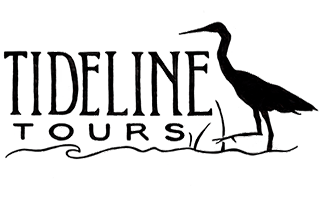Horseshoe Crabs – Creature Feature!
By Capt. Weatherly

While many people are familiar with the sea turtles that visit our beaches to nest, they’re not the only ones laying eggs this time of year. June also marks the peak of horseshoe crab nesting! Horseshoe crabs spend most of their lives offshore, but during late spring and early summer they emerge to spawn. Like many marine species, they synchronize this event with lunar cycles. Smaller males cling to the larger females using their hooked front “legs”. She leads him up the beach, digs a nest, lays eggs, and drags him across to fertilize them before heading back to the sea. What a lady! These eggs are a vital food source for many animals, including species of migratory birds like the threatened red knot which times it’s migration to this event.

If you’ve ever seen one of these alien-like critters on the beach chances are it was a molt – animals with an exoskeleton must shed their out shell to grow larger (hello softshell crabs). Molts are light and have an opening at the front where the animal “walked” out. The easiest way to tell a deceased crab is by smell! Their underside resembles something from a sci-fi movie. A mouth of sorts can be found in the middle of 8 legs and plenty of pinchers. No need for concern; they don’t have enough force to hurt, and the long tail is used to help them flip over if need be. Horseshoe crabs don’t have a stomach and pass food through their gut by moving their legs. Imagine having to walk on a treadmill to eat your lunch! They are graced with a set of compound eyes (like fly eyes) and multiple simple eyes and light receptors on its tail!
Despite their name, horseshoe crabs are not crabs at all and are more closely related to spiders and scorpions. These incredible animals have been around since the time of the dinosaurs and haven’t changed much. If it’s not broken don’t fix it!
A big claim to fame for these prehistoric critters is their use in the medical field. Horseshoe crabs have copper-based blood (called hemolymph) that turns blue when exposed to oxygen! It contains a compound that clumps up in the presence of bacterial toxins and is used to test the sterility of medical equipment and injectable drugs. A local lab safely collects blood from horseshoe crabs—much like a human blood donation—before returning them to the wild.
Occasionally we see horseshoe crabs floating in the water while on a salt marsh adventure boat tour, but more often we see them on Morris Island, Folly Beach, or on our guide favorite low tide sandbar kayaking excursion. Keep your eyes out for one of these prehistoric visitors next time you’re out on the beach!
Found something and want to know more? Send a photo to [email protected] for help identifying and a chance to be in the next Creature Feature!
